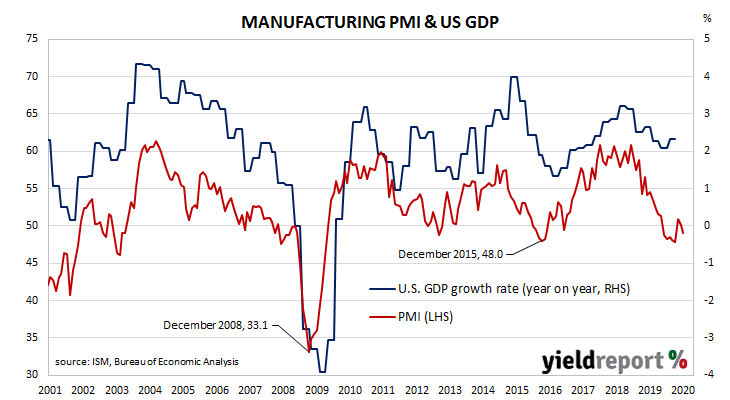US purchasing managers’ indices (PMIs) have been sliding since August 2018, albeit from elevated levels. After reaching a cyclical peak in September 2017, manufacturing PMI readings went sideways for a year before they started a downtrend. Readings then stabilised after a truce of sorts was made with the Chinese regarding trade in late 2019. However, the latest reading implies US manufacturing activity began contracting in March.
According to the latest Institute of Supply Management (ISM) survey, its Purchasing Managers Index recorded a reading of 49.1 in March, considerably higher than the expected figure of 45.0 but lower than February’s final reading of 50.1. The average reading since 1948 is 52.9 and any reading below 50 implies a contraction.
The ISM’s Tim Fiore said, “The coronavirus pandemic and shocks in global energy markets have impacted all manufacturing sectors.” US Treasury yields fell across the curve. By the end of the day, the 2-year Treasury bond yield had shed 2bps to 0.21%, the 10-year yield had lost 8bps to 0.58% while the 30-year yield finished 11bps lower at 1.21%.
US Treasury yields fell across the curve. By the end of the day, the 2-year Treasury bond yield had shed 2bps to 0.21%, the 10-year yield had lost 8bps to 0.58% while the 30-year yield finished 11bps lower at 1.21%.
A month ago, ANZ economist Adelaide Timbrell noted slowing delivery times “owing to delays in receiving inputs” had posed a concern. NAB head of FX Strategy within its FICC division Ray Attrill said a rise in delivery times was behind this latest result. “In normal times this is a sign of demand outstripping the ability to supply, but these are not normal times and the March increase reflected supply chain disruptions due to COVID-19.” He noted other sub-indices had fallen and, in some cases, “quite sharply”.
Purchasing Managers’ Indices (PMIs) are economic indicators derived from monthly surveys of executives in private-sector companies. They are diffusion indices, which means a reading of 50% represents no change from the previous period, while a reading under 50% implies respondents reported a deterioration on average. They are particularly useful as a leading indicator.

